#arthur belasco
Explore tagged Tumblr posts
Text


the story of temple drake, stephen roberts 1933
#the story of temple drake#stephen roberts#1933#miriam hopkins#jack la rue#william gargan#william collier jr.#irving pichel#jobyna howland#guy standing#elizabeth patterson#florence eldridge#james eagles#harlan knight#james mason#louise beavers#arthur belasco#sanctuary#the long hot summer#light in august#romanze in moll#die dritte generation#eraserhead
1 note
·
View note
Text
Claude Rains Character Masterlist!
Here's a handy-dandy guide of all the wonderful characters Claude Rains has portrayed over a nearly seven decade long career. We encourage all to have a gander at all these invisible men, prefects of police, fathers, criminal masterminds, otherworldly beings, and men of history alike! Each link will take you to a picture of that specific character, so even if you're not familiar with them, you can send in propaganda anyhow (such as 'what a lovely wig!', 'astonishing facial hair!', or even 'such a beautiful hat!'). We also realize that two of these characters share a name - John Stevenson (from The Last Outpost and Strange Holiday, respectively), so when submitting propaganda for these characters, please indicate which one! We will try our best to sort through the submissions regardless!
List is in chronological order, however, we are omitting for reasons explained in the pinned post the characters of Clarkis from Build Thy House and The Mayor from The Pied Piper of Hamelin!
(1933) The Invisible Man - Dr. Jack Griffin/The Invisible Man
(1934) Crime Without Passion - Lee Gentry
(1934) The Man Who Reclaimed His Head - Paul Verin
(1935) The Mystery of Edwin Drood - John Jasper
(1935) The Clairvoyant/The Evil Mind - Maximus
(1935) The Last Outpost - John Stevenson
(1936) Hearts Divided - Napoleon Bonaparte
(1936) Anthony Adverse - Marquis Don Luis
(1937) Stolen Holiday - Stefan Orloff
(1937) The Prince and the Pauper - Earl of Hertford/Edward Seymour
(1937) They Won't Forget - D.A. Andrew 'Andy' J. Griffin
(1938) White Banners - Paul Ward
(1938) Gold Is Where You Find It - Colonel Christopher 'Chris' Ferris
(1938) The Adventures of Robin Hood - Prince John
(1938) Four Daughters - Adam Lemp
(1939) They Made Me a Criminal - Detective Monty Phelan
(1939) Juarez - Emperor Louis Napoleon III
(1939) Sons of Liberty - Haym Salomon
(1939) Daughters Courageous - Jim Masters
(1939) Mr. Smith Goes to Washington - Senator Joseph Harrison Paine
(1939) Four Wives - Adam Lemp
(1940) Saturday's Children - Henry Halevy
(1940) The Sea Hawk - Don José Álvarez de Córdoba
(1940) Lady with Red Hair - David Belasco
(1941) Four Mothers - Adam Lemp
(1941) Here Comes Mr. Jordan - Mr. Jordan
(1941) The Wolf Man - Sir John Talbot
(1942) Kings Row - Dr. Alexander Tower
(1942) Moontide - Nutsy
(1942) Now, Voyager - Dr. Jaquith
(1942) Casablanca - Captain Louis Renault
(1943) Forever and a Day - Ambrose Pomfret
(1943) Phantom of the Opera - Erique Claudin/The Phantom
(1944) Passage to Marseille - Captain Freycinet
(1944) Mr. Skeffington - Job Skeffington
(1945) Strange Holiday - John Stevenson
(1945) This Love of Ours - Joseph Targel
(1945) Caesar and Cleopatra - Julius Caesar
(1946) Notorious - Alexander Sebastian
(1946) Angel on My Shoulder - Nick
(1946) Deception - Alexander Hollenius
(1947) The Unsuspected - Victor Grandison
(1949) The Passionate Friends - Howard Justin
(1949) Rope of Sand - Arthur 'Fred' Martingale
(1949) Song of Surrender - Elisha Hunt
(1950) The White Tower - Paul DeLambre
(1950) Where Danger Lives - Frederick Lannington
(1951) Sealed Cargo - Captain Skalder
(1952) The Man Who Watched the Trains Go By/The Paris Express - Kees Poppinga
(1956) Lisbon - Aristides Mavros
(1959) This Earth is Mine - Phillipe Rambeau
(1960) The Lost World - Professor George Edward Challenger
(1961) Battle of the Worlds - Professor Benson
(1962) Lawrence of Arabia - Mr. Dryden
(1963) Twilight of Honor - Art Harper
(1965) The Greatest Story Ever Told - Herod the Great
15 notes
·
View notes
Text
Tony Sansone
Tony Sansone (19 de setembro de 1905 - 13 de janeiro de 1987) foi um fisiculturista e modelo ítalo-americano.
Vida pregressa
Anthony Joseph Sansone nasceu em 19 de setembro de 1905, no Brooklyn, Nova York . Seus pais eram imigrantes sicilianos: Ignazio (Charles) Sansone e Paolina (Pauline) Giardina. Sansone se casou com Sophie Frank (“Rita”) em 1926 e teve dois filhos, Pauline e Anthony Joseph, Jr (“Nino”).
Interesse precoce no desenvolvimento físico
Em tenra idade, Sansone (pronuncia-se sahn-sown-eh, mais tarde americanizado para san-sown-ee) contraiu escarlatina e depois febre tifoide, o que o deixou com uma constituição frágil. Aos 14, ele se interessou por esportes e começou a se exercitar em um parque próximo, fazendo corrida, barra fixa, parada de mão e outras acrobacias. Aos 16, ele se deparou com fotos de revista do astro do físico Tommy Farber na revista Physical Culture e se interessou por desenvolvimento físico. Ele treinou sob a tutela do editor de fisiculturismo Bernarr Macfadden e do fisiculturista Charles Atlas (também conhecido como Angelo Siciliano).
Em outubro de 1923, Sansone, 18, venceu um concurso de fisiculturismo patrocinado pela Atlas. Ele não seguiu carreira no fisiculturismo competitivo, no entanto, e nunca ganhou nenhum título.
Modelagem
Grande parte da fama duradoura de Tony Sansone na história do fisiculturismo foi resultado de seu sucesso como modelo.
Sansone começou a modelar quando ainda era adolescente. Durante a Depressão, Sansone lucrou vendendo fotos suas por meio de anúncios de pedidos pelo correio. Ele se tornou um modelo muito procurado que posou para pinturas, fotografias e esculturas. Ele apareceu em muitas capas de revistas, tanto americanas quanto europeias. Ele modelou para estátuas de James Earle Fraser (“Meriwether Lewis;” Fraser também projetou o níquel de búfalo dos EUA), Arthur Lee (“Rhythm”, que foi criado ao longo de cinco anos, 1925–1930) e Malvina Hoffman (“Nordic Type” e “Elemental Man”).
Sansone publicou vários livros de fotografia, incluindo Modern Classics, Rhythm, Du-ets (sic) e Nudleafs. Em 1936, ele havia vendido mais de 15.000 cópias de Modern Classics e Rhythm combinadas.
Teatro, cinema, empresário
Em meados da década de 1920, Sansone começou a estudar dança como exercício. Ele foi selecionado por Alexandre Gavrilov para atuar no “Ballet Moderne”, que estreou em 10 de abril de 1928. Ele também excursionou com a bailarina polonesa-iugoslava Desha Podgorska. Sua carreira de dança foi interrompida por um acidente no joelho, mas o treinamento influenciou seu estilo de pose.
De 1928 a 1929, Sansone atuou na elaborada produção teatral de ficção científica de David Belasco, Mima . O show teve 180 apresentações.
Entre os espectadores de “Mima” estava o fotógrafo Edwin F. Townsend . Townsend se interessou muito por Sansone e começou a fotografá-lo em 1929. Ele se tornou o principal fotógrafo de Sansone.
Em 1929, Sansone conseguiu um pequeno papel no filme Glorifying the American Girl , do diretor John W. Harkrider, que coestrelou Eddie Cantor . Assim como o fisiculturismo competitivo, Sansone nunca seguiu carreira de ator.
Sansone possuía e operava três academias (que ele chamava de “estúdios de cultura corporal”) na cidade de Nova York. O fisiculturista Steve Reeves estava entre seus clientes.
Físico
Tony Sansone tinha 1,80 m de altura e pesava 84 kg. Seus músculos eram altamente definidos, mas não exibiam o volume massivo comum no fisiculturismo moderno. Sansone, na verdade, não se interessava por medidas, preferindo uma aparência mais esbelta e flexível. Seu treinamento incluía levantamento de peso, corrida, natação e ginástica. Sansone era especialmente forte no trabalho de barra paralela.
Sansone foi fotografado principalmente nu, e foi celebrado por suas poses criativas. Embora naturalmente bronzeado, Sansone realçou seu visual “bronze” com maquiagem corporal. Charles Atlas o chamou de “O Homem Mais Bonito da América”. O historiador de cultura física David Gentle disse “Se Sansone tivesse nascido na antiguidade grega, ele teria sido imortalizado como um deus”.
Vida posterior
Tony Sansone se aposentou do ramo de academias depois de 30 anos. Ele passou a fazer trabalho voluntário, especialmente ensinando crianças carentes.
Sansone morreu em 13 de janeiro de 1987, após uma luta de cinco anos contra o câncer de cólon.

Anthony Sansone (c. 1939), Edwin F. Townsend
830 notes
·
View notes
Photo




Penthouse (Crooks in Clover) (1933) W.S. Van Dyke
April 19th 2020
#penthouse#crooks in clover#1933#w.s. van dyke#warner baxter#myrna loy#nat pendleton#c. henry gordon#charles butterworth#martha sleeper#mae clarke#raymond hatton#arthur belasco#phillips holmes#robert emmett o'connor#george e. stone#pre-code
61 notes
·
View notes
Text
The Algonquin Round Table Onstage
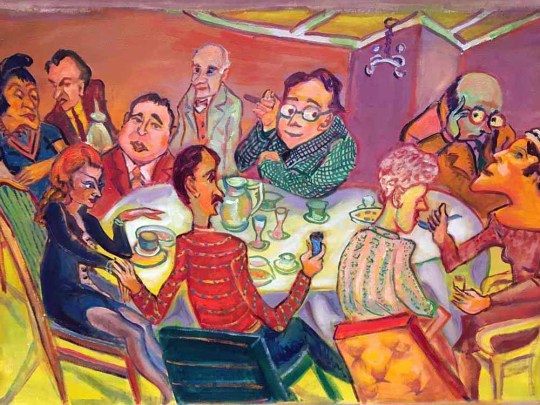
One hundred years ago today, on April 30, 1922, members of the Algonquin Round Table rented the 49th Street Theater for the evening and invited their friends to a satirical revue called No Siree. Its name was a takeoff on that of an immensely popular revue called La Chauve-Souris. Each performer chose his or her guests, ensuring an enthusiastic audience.
Heywood Broun was the MC. The first number was a parody of Eugene O’Neill’s plays Anna Christie and The Hairy Ape called The Greasy Hag (music by Arthur Samuels, played by Jascha Heifetz, no less). It featured an all-male chorus line of F.P.A. (Franklin P. Adams), Robert Benchley, Marc Connelly, George S. Kaufman, John Peter Toohey (a theatrical press agent), and Alexander Woollcott. The setting was up to the audience, multiple choice:

According to Connelly, the sketch included “a line so full of swear words that no one would quote it in mixed company” (the Twenties weren’t that far off from the Victorian Age).
The next number was He Who Gets Flapped, a not-so-subtle play on the title of a current drama called He Who Gets Slapped. It featured an original song by Dorothy Parker and Deems Taylor, “The Everlastin’ Ingenue Blues,” which included the lines
We are little flappers, never growing up, And we’ve all of us been flapping since Belasco was a pup. We’ve got the blues, we mean the blues, You’re the first to hear the devastating news. We’d like to take a crack at playing Lady Macbeth, But we’ll whisper girlish nothings with our dying breath. As far as we’re concerned, there is no sting in death We’ve got those everlasting ingénue blues.
It was sung by the 6’8” Robert Sherwood, in white flannels, blazer, and bowler, surrounded by petite chorus girls who included Tallulah Bankhead, Helen Hayes, Ruth Gillmore, Lenore Ulric, and Mary Brandon (whom Sherwood married later that year).

Above: Dorothy Parker in 1924 and Robert Sherwood in 1928.
Robert Benchley delivered a monologue (which was left off the program, to surprise the audience) that he had thought up in the cab on the way to the theater: a rambling, disjointed report delivered by an ill-prepared company treasurer at a meeting of the board of directors. It was so big a hit that it was filmed six years later, thus beginning a new career for Benchley in Hollywood. It was included, in modified form, in the 1943 film The Sky’s the Limit:
youtube
Other highlights of the program included a spoof of popular playwrights Zoe Akins, called “Zowie, or the Curse of an Akins Heart,” and A.A. Milne, called “Mr. Whim Passes By.” After the show, cast and audience (i.e., their friends) went to a party at the home of Herbert Swope, the editor of the NY World (newspaper), who often played poker with members of the Round Table. It lasted till 4:00 a.m.
A review in the Times the next day called the show silly and amateurish, but a later critic theorized that it marked a turning point in the Vicious Circle, ending their apprenticeship phase and moving into more serious comedy.

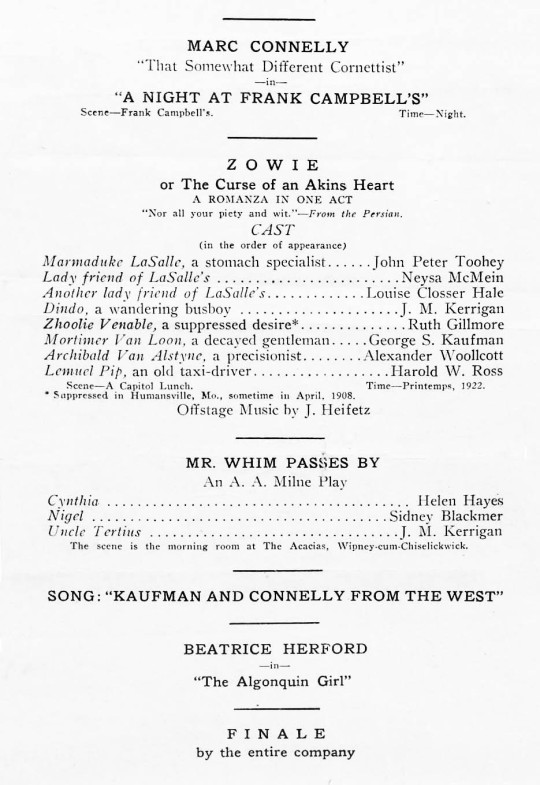
Photos: Painting of the Algonquin Round Table by Milton Yarensky via the Great Neck Record; Dorothy Parker by Vandamm via NYPL; Robert Sherwood by Vandamm via Wikipedia; program from Ashcroft & Moore Auctions
#New York#NYC#vintage New York#1920s#Algonquin Round Table#April 30#No Sirree#Robert Benchley#Dorothy Parker#Robert Sherwood#Heywood Broun#Franklin P. Adams#Marc Connelly#Jascha Heifetz#Milton Yarensky#Helen Hayes#Tallulah Bankhead#Herbert Swope
87 notes
·
View notes
Text
POPPY
1923
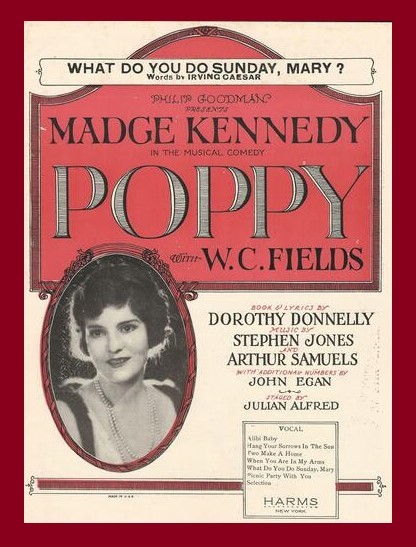
Poppy is a musical in three acts by Dorothy Donnelly with music by Stephen Jones and Arthur Samuels with musical contributions by John Egan. It was produced by Philip Goodman and staged by Donnelly and Julian Alfred, starring Madge Kennedy as Poppy McGargle and featuring W.C. Fields as her adopted father, Professor McGargle.
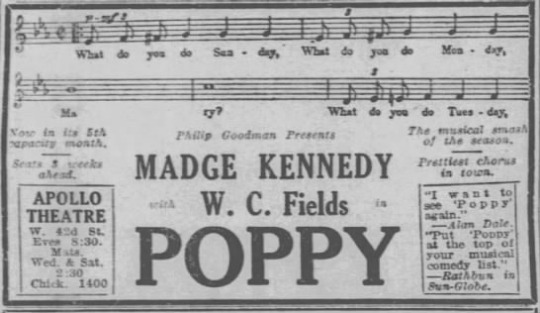
The musical introduced songs such as "Two Make a Home", "On Our Honeymoon", "What Do You Do Sunday, Mary?" and "Alibi Baby".
The musical takes place in Greenmeadow, Connecticut in 1874. Professor Eustice McGargle, a juggler and hustler who runs a traveling circus, adopts an orphan, Poppy. He teaches her to be a con artist. When the circus passes through a small town, Poppy meets a wealthy local boy, William. McGargle learns that Princess Vronski Mameluke Pasha Tubbs has a long-lost daughter, and he tries to pass Poppy off as the heiress. In the end she turns out to be the true heir and marries William.
"What a gorgeous day! What effulgent sunshine! Effulgent sunshine, yes. 'Twas a day of this sort, the McGillicuddy brothers murdered their mother with an axe!" ~ W.C. FIELDS as PROFESSOR MCGARGLE
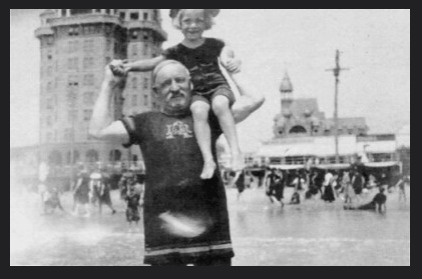
One of W.C. Fields’s first paying jobs as an entertainer was in 1893 when he worked as a juggler at Fortescue’s Pier in Atlantic City. When business was slow, Fields would pretend to be drowning in the ocean and had to be fake rescued. His bosses believed that his near-drowning and dramatic rescue would draw a crowd of customers.
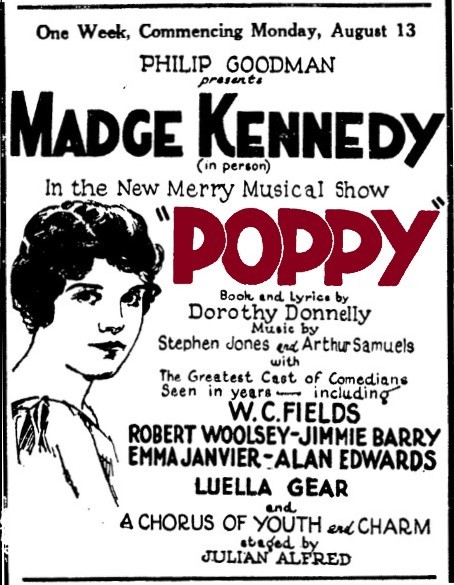
Poppy opened in Atlantic City at Nixon’s Apollo Theatre on August 13, 1923. The week of August 20th, Poppy played a split week in Long Branch and Asbury Park. Just prior to Broadway, it played a week in Newark NJ.
“Our idea of a way to waste what we consider the most charming farceur on the American stage is to cast Miss Madge Kennedy in musical comedy. "Poppy" by any other name at the Main Street would be Just as soporific, so far as Miss Kennedy is concerned.” ~ ASBURY PARK PRESS
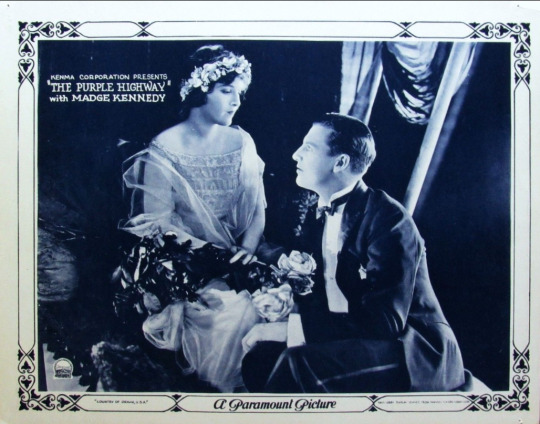
While performing in Poppy, Madge Kennedy was also seen on cinema screens in The Purple Highway. The film was based on a 1921 play, although Kennedy did not star in it on Broadway.

Poppy opened on Broadway at the Apollo Theatre (223 West 42nd Street) on September 3, 1923.
About the Venue: Built in 1910 as the Bryant as 42nd Street's first motion picture and vaudeville house. In 1920, the Selwyn brothers rebuilt it as a legit house, the Apollo. From November 1934 to 1937, burlesque was produced, until the Brandt chain took over. By 1938, it was a popular art and foreign movie house. 1979 to 1983 marked a brief return to legit theatre as the ‘New’ Apollo. Later, it held rock concerts. Architectural elements from the building were incorporated into the Ford Center in 1998.
"’Poppy’ is clean and refreshing by comparison with much of the degenerate stuff which nowadays passes for legitimate amusement in our lighter musical shows.” ~ METCALFE, WALL STREET JOURNAL

“Madge Kennedy Is the Babe Ruth of the stage, after a manner of speaking.” ~ JAMES W. DEAN


During Thanksgiving week, Sunday NY Daily News columnist Sally Joy Brown ran a contest for young people to win tickets to see Poppy, including a backstage visit with Madge Kennedy.
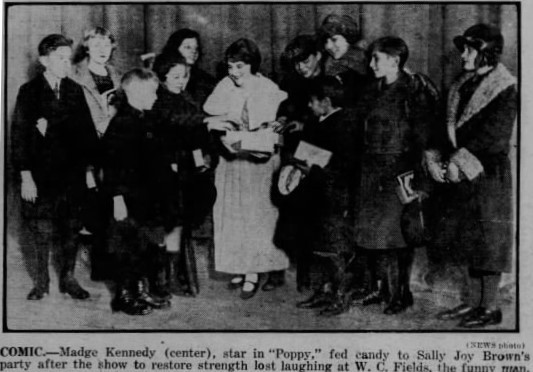
The event was so successful, Brown ran a second contest.
During the run of the play, Kennedy mentored drama students at Columbia University. They had voted her their favorite actress on Broadway.
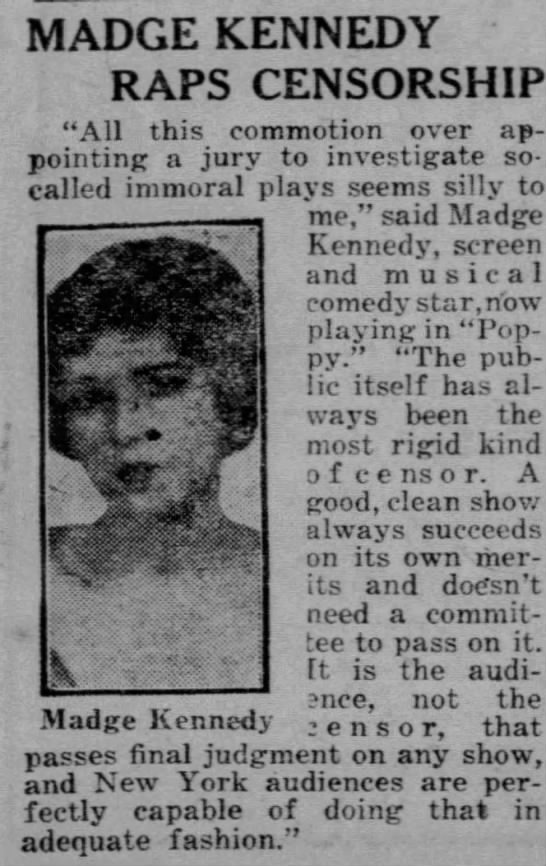
The controversy had caused David Belasco to re-write and re-stage several of his plays to address the NY Attorney General’s concerns.
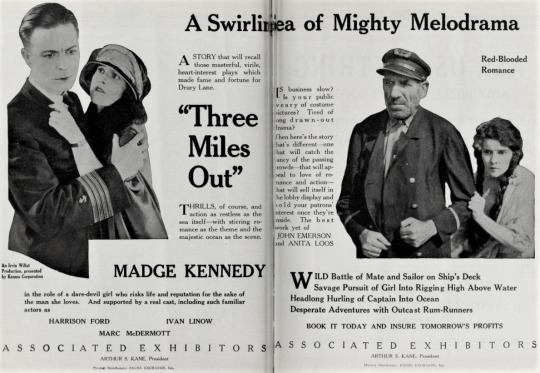
At the end of 1923, yet another Madge Kennedy film opened: Three Miles Out.
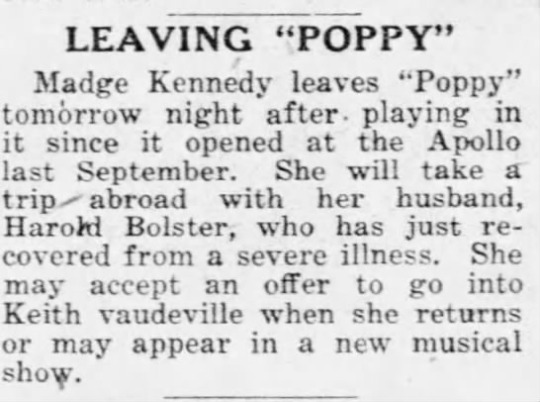
On May 31st, Kennedy played her final performance as Poppy. The title role was assumed by chorus member Victoria White.
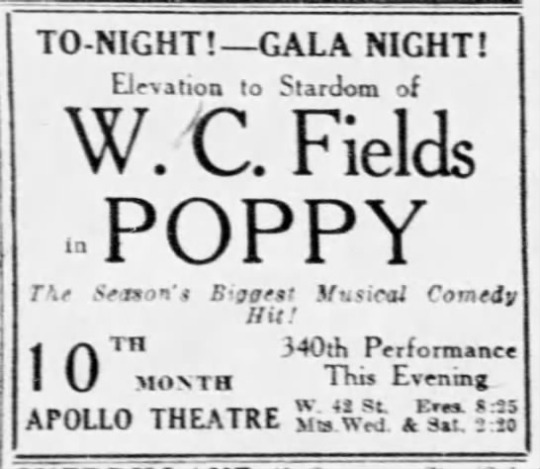
With Kennedy’s departure, Fields was elevated to star status, billed above the title. Telegrams of congratulation to Mr. Fields were read from the stage of the Apollo theatre by Will Rogers, who abandoned his "Follies" rehearsals across the street to act as master of ceremonies. With characteristically witty comments, Mr. Rogers read congratulatory messages from Fred Stone, Eddie Cantor. Leon Erroll, Harold Lloyd, Al Jolson, Walter Catlett, Oscar Shaw, Raymond Hitchcock, Buster Keaton, Lee Shubert, Jerome Kern, and several others. Mr. Fields was greeted with a storm of applause when he stepped forward to acknowledge the felicitations.
Poppy ran 346 performances closing on June 28, 1924. The New York run was followed by a touring production.
In 1924 there was a London production of Poppy at the Gaiety Theatre.

There were two film version, both of which starred Fields as Eustice P. McGargle. The first was Sally of the Sawdust (1925), a silent movie directed by D.W. Griffith and co-starring Carol Dempster as Sally. Griffith had good reason not to use the name or title "Poppy" for this movie. A movie titled Poppy with a character by that name had come out in 1917.
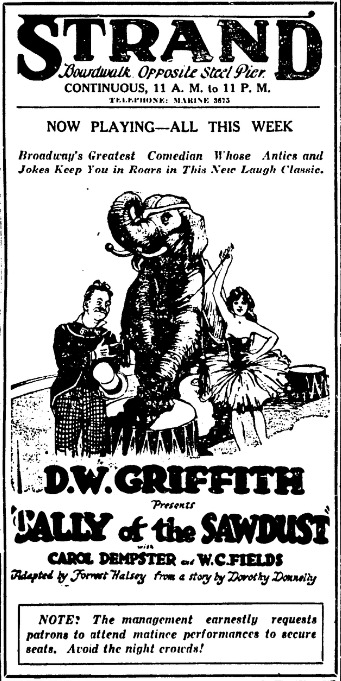
Atlantic City audiences saw Sally on September 7, 1925 at the Strand Theatre on the Boardwalk.
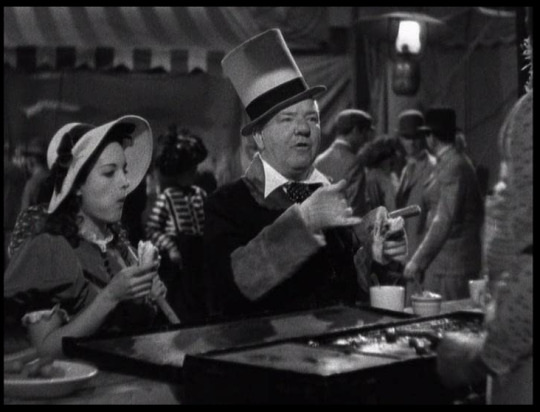
The second was Poppy (1936), directed by A. Edward Sutherland. Fields was ill during the 1936 production, and a fairly obvious double was used in several scenes requiring physical exertion.

The film opened in Atlantic City at the Warner Theatre on the Boardwalk on June 21, 1936. The Warner (later re-named the Warren) was just seven blocks away from Nixon’s Apollo, where the play began in 1923.
"And if we should ever separate, my little plum, I want to give you just one bit of fatherly advice: 'Never give a sucker an even break!'" ~ W.C. FIELDS as PROFESSOR MCGARGLE.
#Madge Kennedy#W.C. Fields#Atlantic City#Nixon's Apollo Theatre#Apollo Theatre#Broadway Musical#Musical#Dorothy Donnelly#1923#Sally of the Sawdust#Poppy#Theatre#Stage
2 notes
·
View notes
Text
Duke Reviews Xtra: A Kid In King Arthur's Court
Hello, I'm Andrew Leduc And Welcome To Duke Reviews Xtra Where We Continue Our Look At Disney...
youtube
And Last Sunday, I Reviewed The Sword And The Stone, So, Since There's No Direct To DVD Sequel Or Remake To This...Yet..., I'm Reviewing The Only Other King Arthur Film Made By Disney That Wasn't Made By Jerry Bruckheimer, A Kid In King Arthur's Court...
This Film Sees Merlin's Ghost Sending A Dude From The 90's To Camelot To Save It From King Arthur's Evil Advisor Who Wants To Marry Rose From Titanic...
And Believe Me When I Say Billy Zane Was The Better Suitor Compared To This Guy...
Will Calvin Be Able To Save Camelot And Get Arthur Back To His Heroic Self?
Let's Find Out As We Watch A Kid In King Arthur's Court..
The Film Starts With Merlin's Ghost (Played By Fagin From Oliver) Summoning A Great Knight Which Is When We Cut To The 90's Where We Meet Calvin Fuller, A Nerdy Young Boy Who Plays For A Baseball Team Called The Knights...

But As We See He's Not Quite The Best Player On The Team...
However, An Earthquake Happens Causing Calvin To Fall Down...
(Singing)
Down...
Deep Below...
To The Late...1800s....
Landing On A Black Knight, Calvin Scares Him Off And Gives Back The Money The Guy Stole To Some Of Arthur's Knights As He Runs...
Arthur (Played By DeNomolos From Bill And Ted's Bogus Journey) Wishes To Thank The Boy So He Sends The Knights To Find Him, Eventually Finding Calvin In The City They Bring Him Before Arthur And His 2 Daughters, Katie And Sarah (Played By Winslet)...
Who Invite Him To Have Dinner With Them, But Arthur's Aide (And Our Villain For This Movie) Lord Belasco Believes Calvin To Be In League With The Black Knight, So Giving Calvin A Chance To Defend His Honor By Combat...
But While Belasco Chooses A Sword, Calvin (Realizing He's Not Good With Weapons) Uses The Only Thing He Does Like, Rock And Roll And Wins...

Dubing Him Calvin Fuller Of Reseda, He Discovers The Round Table Is Non Existant As Sarah Asks Her Father To Let Sir Kane (Played By James Bond)...
Which One?
Daniel Craig
Oh...
Train Calvin In Fighting, And He Agrees, And Let's Calvin Stay In Their Castle...
But He Doesn't Exactly Get Any Rest As When He Goes Exploring The Castle, Belasco Nearly Kills Him, So He Practices His Karate Only To Catch Arthur's Daughter, Katie Watching Him...
They Get To Know Each Other Through A Bunch Of Exposition...
youtube
Before Katie Takes Calvin To Merlin's Quarters In An Effort To Get Him Home...
Hearing A Noise, Katie Leaves With Calvin And Has Him Escort Her Back To Her Room, But He Returns To Merlin's Quarters Afterwards And Merlin's Ghost, Who Believes He's Made A Mistake When He Looks At Calvin..

But Realizing That He's The Knight He Summoned, He Tells Him That Arthur Is In Trouble With His Kingdom Being Shattered By The Fist Of Lord Belasco, Who Intends To Steal Camelot From Arthur And It's Now Up To Calvin To Stop Him...

I Bet He Wishes He Was Obi Wan Kenobi...
With Calvin Believing Merlin Has The Wrong Person, Merlin Makes A Deal With Him That If He Helps Arthur He'll Send Him Home...
The Next Morning, Calvin Begins Training With Sir Kane By Starting Out With Attacking On Horseback, (Where He Throws An Axe Out Of A Window) Before Moving On To Archery Where...
Well, Let's Just Say Calvin Won't Be As Good As Oliver Queen Any Time Soon...
Meanwhile, Lord Belasco Talks With Sarah To Try To Seduce Her In An Effort To Drop The Tournament And Marry Him, But Sarah Refuses, Stating That The Tournament Will Decide For Her...

Visiting A Blacksmith, Calvin Asks If He Can Make Him A Pair Of Roller Skates For Katie, And In Doing So, She Absolutely Loves Them...
Meanwhile At The New "Round Table" Belasco Talks With Arthur To Make Him Cancel The Tournament And Let Sarah Be His Wife, As Katie And Calvin Arrive To His Displeasure...
Later At Training With Kane And Katie, They Are Interrupted By Belasco Who Is Tired Of Calvin And Decides To Fight Him Again, But When Calvin Is Basically Beat, He Kicks Belasco In The Jewels...

Giving Him A Grand Supper For Winning, Calvin Says Fine As Long As He Does The Cooking...
Yeah, Even I Admit That Pork Head Can Get Tiring After A While..

So, He Makes Them 2 Big Macs...
Meanwhile, In The Throne Room, The King Tells Katie That She Will Marry Lord Belasco, However Sarah Is Determined To Let The Tournament Decide But The Next Day It Is Revealed That Katie Is In Love With Sir Kane...
I Don't See James Bond As Your Type, Sarah, But I Can Suggest An Artist Named Dawson For You...
With Katie And Calvin Seeing The Entire Thing, She Makes Calvin Swear Not To Say A Word To Anyone On Her Honor...
With Kane Believing That Calvin Is Ready To Joust, Calvin Isn't So Sure, So He Places Super Glue? On His Saddle And When He Hits The Target, The Saddle Falls Off The Horse...
youtube
Katie Goes To Check Calvin Who Looks Injured Only For Calvin To Slip Her A Kiss, To Her Displeasure...
Realizing He Might Have Made Katie Mad...
No, Really?
Calvin Visits The Blacksmith Again, Only This Time Calvin Wants Him To Make A Bike For Katie...
While Katie Talks With Sarah Who Figures Out That She's In Love With Calvin Even Though She Doesn't Realize It...
youtube
(Start At 9:52, End At 10:33)
Really, Man, They're Sisters! Get A Grip!
Anyway, The Next Day, After Calvin Teaches Arthur How To Eat Bubble Gum, He Tells Belasco That The Tournament Is Still On And That If He Wants To Win Her He Must Do It There, But Not Wanting To, He Moves To Plan B...
But Before I Go On To That, Let's Check On Calvin And Katie...
Seeing Calvin In The Garden, He Gives Her The Bike So They Can Go On A Picnic Together...
On Their Way Back To The Castle Calvin And Katie Discover That The Black Knight Is Actually One Of The Good Guys, When He Gives The Townspeople A Cart Filled With Food...
Taking Katie Back To Her Room, We Meet Belasco's Plan B: Kidnap Katie As A Barter For Sarah To Marry Him...

After Telling Sarah About Katie, Belasco Visits Calvin And Frames Him For Kidnapping Katie (Oh, Sorry Murder), But When Calvin Gets Away, He Runs Into Sarah Who Tells Him What Happened To Katie And What Belasco Wants...
Eventually Going To Arthur's Chambers, Calvin Tells Him Everything But He Still Believes That Belasco Wouldn't Hurt A Fly However, When Calvin Shows Arthur Something That Sarah Gave Him, He Buys The Story And Protects Calvin From Belasco...
Escaping With Calvin Into The City, They Go Undercover, As Arthur Discovers That He's Not As Loved Throughout The Kingdom As He Thought As Belasco Has Been Stealing From Them For Years...
Vowing To Be A Better King, Arthur And Calvin Go To Save Katie From Belasco's Dungeon, But Before Going In Calvin Renews Arthur's Will To Fight By Giving Him Excalibur (Which Was Given To Him By Merlin)
However, When They Release Katie, She Gets Kidnapped Again By Belasco's Second In Command And Is Held Hostage Over A Moat, This Leads Calvin To Use The Laser On His CD Player To Blind The Guard And Cause Him To Fall To His Death...
Now, I Hate To Say This But I Got To Agree With The Nostalgia Critic When He Said That A Laser On A CD Player Doesn't Work Like That...
youtube
Escaping The Castle, Arthur Knights Calvin As A Knight Of The Round Table, Before Returning To The Castle And..,Letting Belasco Go?
Yeah, Even I Kind Of Think Letting Him Is Kind Of Stupid...
However, Arthur Has A Point, With The Guards Loyal To Belasco And The People Believing Arthur To Be An Idiot, The Best Thing To Do Is To Bide Their Time So When The Time Is Right They Can Nail Him...
Later At The Tournament, Arthur Makes A Speech That He Never Betray His People Again And Declares That The Tournament Shall Be Open To All Free Men (Mainly So Kane Can Enter The Competition)...
Defeating Every Opponent That Comes His Way, Kane Ends Up Facing Off Against Belasco In The Final Battle, But Using The Crystal On His Armor, Belasco Blinds Kane And Knocks Him Out...
But Seeing How Kane Did Not Fall Off His Horse, He Is Still In The Competition, However, When Kane Returns The Joust Continues....

But Everyone Soon Gets A Scare, When Belasco Hits Kane In The Head And Discovers He Has No Head...
Well, How's He Going To Have His Vodka Martini Now?
With A Now Headless Kane Continuing, He Ends Up Winning And Knocking Belasco Off Of His Horse...
Which Leads To It Being Revealed That It Wasn't Kane, But Calvin All Along. Pissed Off At His Defeat, Belasco Attempts To Kill Calvin, But Luckily, Calvin Is Saved By The Black Knight Who Is Revealed To Have Been Sarah This Whole Time..

So, With Calvin Forfeiting His Victory To Sarah, Arthur Grants Her The Right To Choose Whoever She Wants To Marry And Banishes Belasco From His Kingdom Forever As Merlin Keeps His Word And Sends Calvin Back To His Time, Saying Farewell To Arthur And Katie..
Arriving Before The Earthquake, Calvin Goes Up To The Plate And Hits A Home Run. Arriving Back On Home Plate, He Is Greeted By His Teammates, Including A Girl Who Looks Like Katie, As A Spectator Who Looks Like Arthur Watches In The Crowd As Our Movie Ends..,
And That's A Kid In King Arthur's Court, And While It Does Have It's Stupid Moments, It Is A Decent Movie...
The Story Is Good, The Comedy Can Be Funny At Times, And I Liked The Fighting Scenes In It, So, Yeah, I'm Going To Say See It...
Tune In To Duke Reviews Next Week As We Look At The Jungle Book, But Then, This Is Duke, Signing Off...
#A Kid In King Arthurs Court#thomas ian nicholas#Kate Winslet#daniel craig#Joss Ackland#art malik#Ron Moody#disney#disney +#disnerd
2 notes
·
View notes
Text
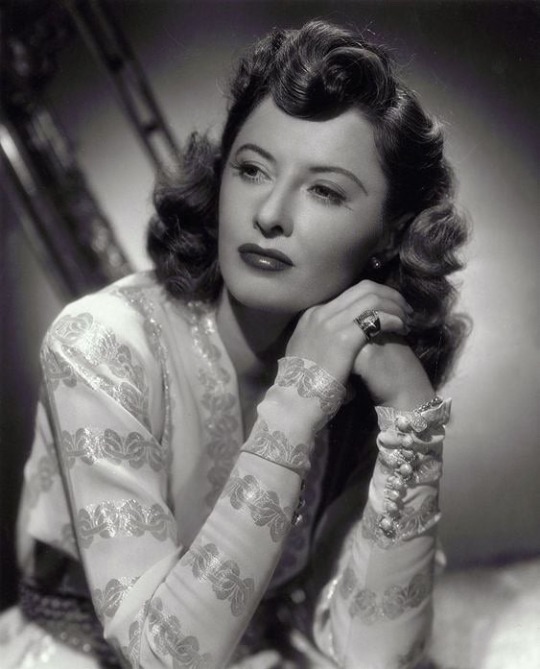
Barbara Stanwyck (born Ruby Catherine Stevens; July 16, 1907 – January 20, 1990) was an American actress, model and dancer. A stage, film and television star, she was known during her 60-year career as a consummate and versatile professional for her strong, realistic screen presence. A favorite of directors including Cecil B. DeMille, Fritz Lang and Frank Capra, she made 85 films in 38 years before turning to television.
Stanwyck got her start on the stage in the chorus as a Ziegfeld girl in 1923 at age 16 and within a few years was acting in plays. She was then cast in her first lead role in Burlesque (1927), becoming a Broadway star. Soon after that, Stanwyck obtained film roles and got her major break when Frank Capra chose her for his romantic drama Ladies of Leisure (1930), which led to additional lead roles.
In 1937 she had the title role in Stella Dallas and received her first Academy Award nomination for best actress. In 1941 she starred in two successful screwball comedies: Ball of Fire with Gary Cooper, and The Lady Eve with Henry Fonda. She received her second Academy Award nomination for Ball of Fire, and in recent decades The Lady Eve has come to be regarded as a romantic comedy classic with Stanwyck's performance called one of the best in American comedy.
By 1944, Stanwyck had become the highest-paid woman in the United States. She starred alongside Fred MacMurray in the seminal film noir Double Indemnity (1944), playing the smoldering wife who persuades MacMurray's insurance salesman to kill her husband. Described as one of the ultimate portrayals of villainy, it is widely thought that Stanwyck should have won the Academy Award for Best Actress rather than being just nominated. She received another Oscar nomination for her lead performance as an invalid wife overhearing her own murder plot in the thriller film noir, Sorry, Wrong Number (1948). After she moved into television in the 1960s, she won three Emmy Awards – for The Barbara Stanwyck Show (1961), the western series The Big Valley (1966), and miniseries The Thorn Birds (1983).
She received an Honorary Oscar in 1982, the Golden Globe Cecil B. DeMille Award in 1986 and was the recipient of several other honorary lifetime awards. She was ranked as the 11th greatest female star of classic American cinema by the American Film Institute. An orphan at the age of four, and partially raised in foster homes, she always worked; one of her directors, Jacques Tourneur, said of Stanwyck, "She only lives for two things, and both of them are work."
Barbara Stanwyck was born Ruby Catherine Stevens on July 16, 1907, in Brooklyn, New York. She was the fifth – and youngest – child of Catherine Ann (née McPhee) (1870-1911) and Byron E. Stevens (1872-1919), working-class parents. Her father, of English descent, was a native of Lanesville, Massachusetts, and her mother, of Scottish descent, was an immigrant from Sydney, Nova Scotia. When Ruby was four, her mother died of complications from a miscarriage after she was knocked off a moving streetcar by a drunk. Two weeks after the funeral, her father joined a work crew digging the Panama Canal and was never seen again by his family. Ruby and her older brother, Malcolm Byron (later nicknamed "By") Stevens, were raised by their eldest sister Laura Mildred, (later Mildred Smith) (1886–1931), who died of a heart attack at age 45. When Mildred got a job as a showgirl, Ruby and Byron were placed in a series of foster homes (as many as four in a year), from which young Ruby often ran away.
"I knew that after fourteen I'd have to earn my own living, but I was willing to do that ... I've always been a little sorry for pampered people, and of course, they're 'very' sorry for me."
Ruby toured with Mildred during the summers of 1916 and 1917, and practiced her sister's routines backstage. Watching the movies of Pearl White, whom Ruby idolized, also influenced her drive to be a performer. At the age of 14, she dropped out of school, taking a package wrapping job at a Brooklyn department store. Ruby never attended high school, "although early biographical thumbnail sketches had her attending Brooklyn's famous Erasmus Hall High School."
Soon afterward, she took a filing job at the Brooklyn telephone office for $14 a week, which allowed her to become financially independent. She disliked the job; her real goal was to enter show business, even as her sister Mildred discouraged the idea. She then took a job cutting dress patterns for Vogue magazine, but customers complained about her work and she was fired. Ruby's next job was as a typist for the Jerome H. Remick Music Company; work she reportedly enjoyed, however her continuing ambition was in show business, and her sister finally gave up trying to dissuade her.
In 1923, a few months before her 16th birthday, Ruby auditioned for a place in the chorus at the Strand Roof, a nightclub over the Strand Theatre in Times Square. A few months later, she obtained a job as a dancer in the 1922 and 1923 seasons of the Ziegfeld Follies, dancing at the New Amsterdam Theater. "I just wanted to survive and eat and have a nice coat", Stanwyck said. For the next several years, she worked as a chorus girl, performing from midnight to seven a.m. at nightclubs owned by Texas Guinan. She also occasionally served as a dance instructor at a speakeasy for gays and lesbians owned by Guinan. One of her good friends during those years was pianist Oscar Levant, who described her as being "wary of sophisticates and phonies."
Billy LaHiff, who owned a popular pub frequented by showpeople, introduced Ruby in 1926 to impresario Willard Mack. Mack was casting his play The Noose, and LaHiff suggested that the part of the chorus girl be played by a real one. Mack agreed, and after a successful audition gave the part to Ruby. She co-starred with Rex Cherryman and Wilfred Lucas. As initially staged, the play was not a success. In an effort to improve it, Mack decided to expand Ruby's part to include more pathos. The Noose re-opened on October 20, 1926, and became one of the most successful plays of the season, running on Broadway for nine months and 197 performances. At the suggestion of David Belasco, Ruby changed her name to Barbara Stanwyck by combining the first name from the play Barbara Frietchie with the last name of the actress in the play, Jane Stanwyck; both were found on a 1906 theater program.
Stanwyck became a Broadway star soon afterward, when she was cast in her first leading role in Burlesque (1927). She received rave reviews, and it was a huge hit. Film actor Pat O'Brien would later say on a 1960s talk show, "The greatest Broadway show I ever saw was a play in the 1920s called 'Burlesque'." Arthur Hopkins described in his autobiography To a Lonely Boy, how he came to cast Stanwyck:
After some search for the girl, I interviewed a nightclub dancer who had just scored in a small emotional part in a play that did not run [The Noose]. She seemed to have the quality I wanted, a sort of rough poignancy. She at once displayed more sensitive, easily expressed emotion than I had encountered since Pauline Lord. She and Skelly were the perfect team, and they made the play a great success. I had great plans for her, but the Hollywood offers kept coming. There was no competing with them. She became a picture star. She is Barbara Stanwyck.
He also called Stanwyck "The greatest natural actress of our time", noting with sadness, "One of the theater's great potential actresses was embalmed in celluloid."
Around this time, Stanwyck was given a screen test by producer Bob Kane for his upcoming 1927 silent film Broadway Nights. She lost the lead role because she could not cry in the screen test, but was given a minor part as a fan dancer. This was Stanwyck's first film appearance.
While playing in Burlesque, Stanwyck was introduced to her future husband, actor Frank Fay, by Oscar Levant. Stanwyck and Fay were married on August 26, 1928, and soon moved to Hollywood.
Stanwyck's first sound film was The Locked Door (1929), followed by Mexicali Rose, released in the same year. Neither film was successful; nonetheless, Frank Capra chose Stanwyck for his film Ladies of Leisure (1930). Her work in that production established an enduring friendship with the director and led to future roles in his films. Other prominent roles followed, among them as a nurse who saves two little girls from being gradually starved to death by Clark Gable's vicious character in Night Nurse (1931). In Edna Ferber's novel brought to screen by William Wellman, she portrays small town teacher and valiant Midwest farm woman Selena in So Big! (1932). She followed with a performance as an ambitious woman "sleeping" her way to the top from "the wrong side of the tracks" in Baby Face (1933), a controversial pre-Code classic. In The Bitter Tea of General Yen (1933), another controversial pre-Code film by director Capra, Stanwyck portrays an idealistic Christian caught behind the lines of Chinese civil war kidnapped by warlord Nils Asther. A flop at the time, containing "mysterious-East mumbo jumbo", the lavish film is "dark stuff, and its difficult to imagine another actress handling this ... philosophical conversion as fearlessly as Ms. Stanwyck does. She doesn't make heavy weather of it."
In Stella Dallas (1937) she plays the self-sacrificing title character who eventually allows her teenage daughter to live a better life somewhere else. She landed her first Academy Award nomination for Best Actress when she was able to portray her character as vulgar, yet sympathetic as required by the movie. Next, she played Molly Monahan in Union Pacific (1939) with Joel McCrea. Stanwyck was reportedly one of the many actresses considered for the role of Scarlett O'Hara in Gone with the Wind (1939), although she did not receive a screen test. In Meet John Doe she plays an ambitious newspaperwoman with Gary Cooper (1941).
In Preston Sturges's romantic comedy The Lady Eve (1941), she plays a slinky, sophisticated con-woman who falls for her intended victim, the guileless, wealthy snake-collector and scientist Henry Fonda, she "gives off an erotic charge that would straighten a boa constrictor." Film critic David Thomson described Stanwyck as "giving one of the best American comedy performances", and its reviewed as brilliantly versatile in "her bravura double performance" by The Guardian. The Lady Eve is among the top 100 movies of all time on Time and Entertainment Weekly's lists, and is considered to be both a great comedy and a great romantic film with its placement at #55 on the AFI's 100 Years ...100 Laughs list and #26 on its 100 Years ...100 Passions list.
Next, she was the extremely successful, independent doctor Helen Hunt in You Belong to Me (1941), also with Fonda. Stanwyck then played nightclub performer Sugerpuss O'Shea in the Howard Hawks directed, but Billy Wilder written comedy Ball of Fire (1941). In this update of the Snow White and Seven Dwarfs tale, she gives professor Gary Cooper a better understanding of "modern English" in the performance for which she received an Academy Award nomination for Best Actress.
In Double Indemnity, the seminal film noir thriller directed by Billy Wilder, she plays the sizzling, scheming wife/blonde tramp/"destiny in high heels" who lures an infatuated insurance salesman (Fred MacMurray) into killing her husband. Stanwyck brings out the cruel nature of the "grim, unflinching murderess", marking her as the "most notorious femme" in the film noir genre. Her insolent, self-possessed wife is one of the screen's "definitive studies of villainy - and should (it is widely thought) have won the Oscar for Best Actress", not just been nominated. Double Indemnity is usually considered to be among the top 100 films of all time, though it did not win any of its seven Academy Award nominations. It is the #38 film of all time on the American Film Institute's list, as well as the #24 on its 100 Years ...100 Thrillers list and #84 on its 100 Years ...100 Passions list.
She plays the columnist caught up in white lies and a holiday romance in Christmas in Connecticut (1945). In 1946 she was "liquid nitrogen" as Martha, a manipulative murderess, costarring with Van Heflin and newcomer Kirk Douglas in The Strange Love of Martha Ivers. Stanwyck was also the vulnerable, invalid wife that overhears her own murder being plotted in Sorry, Wrong Number (1948) and the doomed concert pianist in The Other Love (1947). In the latter film's soundtrack, the piano music is actually being performed by Ania Dorfmann, who drilled Stanwyck for three hours a day until the actress was able to synchronize the motion of her arms and hands to match the music's tempo, giving a convincing impression that it is Stanwyck playing the piano.
Pauline Kael, a longtime film critic for The New Yorker, admired the natural appearance of Stanwyck's acting style on screen, noting that she "seems to have an intuitive understanding of the fluid physical movements that work best on camera". In reference to the actress's film work during the early sound era, Kael observed that the "early talkies sentimentality...only emphasizes Stanwyck's remarkable modernism."
Many of her roles involve strong characters, yet Stanwyck was known for her accessibility and kindness to the backstage crew on any film set. She knew the names of their wives and children. Frank Capra said of Stanwyck: "She was destined to be beloved by all directors, actors, crews and extras. In a Hollywood popularity contest, she would win first prize, hands down." While working on 1954s Cattle Queen of Montana on location in Glacier National Park, she did some of her own stunts, including a swim in the icy lake.[49] A consummate professional, when aged 50, she performed a stunt in Forty Guns. Her character had to fall off her horse and, with her foot caught in the stirrup, be dragged by the galloping animal. This was so dangerous that the movie's professional stunt person refused to do it. Her professionalism on film sets led her to be named an Honorary Member of the Hollywood Stuntmen's Hall of Fame.
William Holden and Stanwyck were longtime friends and when Stanwyck and Holden were presenting the Best Sound Oscar for 1977, he paused to pay a special tribute to her for saving his career when Holden was cast in the lead for Golden Boy (1939). After a series of unsteady daily performances, he was about to be fired, but Stanwyck staunchly defended him, successfully standing up to the film producers. Shortly after Holden's death, Stanwyck recalled the moment when receiving her honorary Oscar: "A few years ago, I stood on this stage with William Holden as a presenter. I loved him very much, and I miss him. He always wished that I would get an Oscar. And so, tonight, my golden boy, you got your wish."
As Stanwyck's film career declined during the 1950s, she moved to television. In 1958 she guest-starred in "Trail to Nowhere", an episode of the Western anthology series Dick Powell's Zane Grey Theatre, portraying a wife who pursues, overpowers, and kills the man who murdered her husband. Later, in 1961, her drama series The Barbara Stanwyck Show was not a ratings success, but it earned her an Emmy Award. The show ran for a total of thirty-six episodes. She also guest-starred in this period on other television series, such as The Untouchables with Robert Stack and in four episodes of Wagon Train.
She stepped back into film for the 1964 Elvis Presley film Roustabout, in which she plays a carnival owner.
The western television series, The Big Valley, which was broadcast on ABC from 1965 to 1969, made her one of the most popular actresses on television, winning her another Emmy. She was billed in the series' opening credits as "Miss Barbara Stanwyck" for her role as Victoria, the widowed matriarch of the wealthy Barkley family. In 1965, the plot of her 1940 movie Remember the Night was adapted and used to develop the teleplay for The Big Valley episode "Judgement in Heaven".
In 1983, Stanwyck earned her third Emmy for The Thorn Birds. In 1985 she made three guest appearances in the primetime soap opera Dynasty prior to the launch of its short-lived spin-off series, The Colbys, in which she starred alongside Charlton Heston, Stephanie Beacham and Katharine Ross. Unhappy with the experience, Stanwyck remained with the series for only the first season, and her role as "Constance Colby Patterson" would be her last. It was rumored Earl Hamner Jr., former producer of The Waltons, had initially wanted Stanwyck for the role of Angela Channing in the 1980s soap opera Falcon Crest, and she turned it down, with the role going to her friend, Jane Wyman; when asked Hamner assured Wyman it was a rumor.
Stanwyck's retirement years were active, with charity work outside the limelight. In 1981, she was awakened in the middle of the night, inside her home in the exclusive Trousdale section of Beverly Hills, by an intruder, who first hit her on the head with his flashlight, then forced her into a closet while he robbed her of $40,000 in jewels.
The following year, in 1982, while filming The Thorn Birds, the inhalation of special-effects smoke on the set may have caused her to contract bronchitis, which was compounded by her cigarette habit; she was a smoker from the age of nine until four years before her death.
Stanwyck died on January 20, 1990, aged 82, of congestive heart failure and chronic obstructive pulmonary disease (COPD) at Saint John's Health Center in Santa Monica, California. She had indicated that she wanted no funeral service. In accordance with her wishes, her remains were cremated and the ashes scattered from a helicopter over Lone Pine, California, where she had made some of her western films.
6 notes
·
View notes
Photo



Two Minute Date: Hugh Dancy by Kelly Marages ( May 7, 2007 )
Hugh Dancy is so well behaved that you can't help but wonder if he's hiding something juicier than his inner librarian. "You become quite nerdy sometimes," says Dancy, reflecting on his history-rich roles in Elizabeth I and King Arthur while sitting on a futon in his dressing room at Manhattan's Belasco Theatre, where he's performing in—more history!— the WWI classic, Journey's End. (The New York Times raved, saying that Dancy has "the cheekbones and brooding gaze of Olivier in his matinee idol era." Dreamy.) "I could bore you to tears about a lot of fairly arcane subjects, like the reign of Elizabeth I, or the history of Rwanda, or the day-to-day conditions of an officer in the First World War. But you have to be careful. Sometimes you can overestimate how much people really care.
"But we do care, Hugh, we really do. Dancy, 31, who's on schedule to be the next big British It boy, has more than acting chops going for him: For starters, there's his relationship with the fetching Claire Danes, whom he met on the set of the upcoming melodrama Evening. There's also his exquisite boy-next-door looks. Today, his fresh-faced appeal is underscored by the neat jeans and gray turtleneck sweater he wears, to say nothing of the sparkling eyes and perfectly disheveled chestnut mop—recalling, perhaps, another iconic Brit It, his floppiness Hugh Grant.
As it happens, both went to Oxford. But whereas one can't picture Grant starring in, say, a film about genocide, that's exactly the kind of gravitas Dancy goes for. In his latest vehicle, Beyond the Gates, he plays a naive young teacher from the U.K. who, along with a Catholic priest played by John Hurt, protects Tutsis by sheltering them in their local school. The film ends with a devastating moral choice: Will Dancy's character flee back to Britain or stay in solidarity and face certain death at the hands of a machete-wielding mob?
"I think that most of us would be far more likely to save our own lives," he says, mercifully without stammering as Grant might. "I think that for an individual, that's a completely understandable reaction."
That willingness to engage in life's heaviest questions will almost certainly keep Dancy from being reduced to It-ness, which suits him fine. "Of all the things that can happen to somebody in life, that's got to be one of the weirder things," he says of being so labeled by the media. "I realize that basically the only kind of control you have over your career as an actor is recognizability, so I want that. But I'm not willing to keep doing the same thing over and over and over again just to be recognizable. So you try to have your cake and eat it in that way."
So then, maybe by his reckoning, he's made it already? "I'm too superstitious to commit something that hubristic to print. Ever," Dancy says, laughing. "But I will say this: I'm sitting here, and I've got these movies coming out, and I'm doing a play. Superstition aside, I can't think of a better place to be."
38 notes
·
View notes
Link
In November 1960 a beautiful play came to the Belasco. Tad Mosel’s All the Way Home, adapted from James Agee’s novel A Death in the Family, starred Arthur Hill, Lillian Gish, Colleen Dewhurst, and Aline MacMahon. It etched with feeling the impact of a young fathers death on his family. It was awarded the Pulitzer Prize and the New York Drama Critics Circle Award as the best play of the season. In April 1930 producer Jed Harris, known as the boy wonder, returned from London and produced and directed an acclaimed revival of Chekhov’s Uncle Vanya, adapted by Mrs. Ben Hecht (Rose Caylor). Harris’s direction and the acting of his sterling cast, Lillian Gish, Osgood Perkins, Walter Connolly, Eduardo Ciannelli Joanna Roos, and others, made the occasion a theatrical event. A dramatization of the infamous Lizzie Borden ax murders, Nine Pine Street, had a fine performance by Lillian Gish as the neurotic killer, but it only ran a few weeks in 1933. The National had a series of failures and quick bookings during 1932 and 1933 and was dark for more than a year during those gray Depression days. But on October 22, 1934, a distinguished drama opened at this theatre. It was Sean O’Casey’s Within the Gates, directed by Melvyn Douglas and starring Lillian Gish as a prostitute, Bramwell Fletcher as a poet, and Moffat Johnston as a bishop. The play took place in London’s Hyde Park, and the very large cast represented the great variety of humanity who spent their days in the park.
0 notes
Text
Round One Poll Master Post
Here, you can find all the active polls and this post will be updated with each new poll! Best of luck to all the Claudes!
~Round One Matchups~
Marquis Don Luis vs Paul Delambre
Lee Gentry vs David Belasco
Ambrose Pomfret vs Phillipe Rambeau
Professor Benson vs Professor George Edward Challenger
Sir John Talbot vs Dr. Jaquith
Howard Justin vs Joseph Targel
Frederick Lannington vs Colonel Christopher Ferris
Captain Skalder vs Detective Monty Phelan
Kees Poppinga vs Henry Halevy
Napoleon Bonaparte vs Emperor Louis Napoleon III
Stefan Orloff vs Elisha Hunt
John Stevenson vs John Stevenson
Art Harper vs The Earl of Hertford
Julius Caesar vs Paul Verin
Jim Masters vs Maximus
Captain Freycinet vs Andrew Griffin
Aristides Mavros vs Nutsy
Herod the Great vs Arthur 'Fred' Martingale
John Jasper vs Adam Lemp
Haym Salomon vs Paul Ward
Don José Álvarez de Córdoba vs Dr. Alexander Tower
Senator Joseph Harrison Paine vs. Mr. Dryden
Mr. Jordan vs Prince John
Job Skeffington vs Erique Claudin
Nick vs Victor Grandison
Alexander Sebastian vs Alexander Hollenius
Captain Louis Renault vs Dr. Jack Griffin
#claude rains#kingoftheclaudes#kingoftheclaudespoll#reference post#polls#tumblr polls#classic hollywood#old hollywood#vintage hollywood
10 notes
·
View notes
Text
DECEMBER 2020
PAGE RIB
Peace!!
*****
Joe Biden is the President elect with Kamala Harris as VP. Emily Murphy of the General Services Administration has finally allowed them to begin the transition.** A. Blinken will be the new Sec. of state. By the end of the month, Joe feel while playing with his dog and has a hairline fracture.
*****
Ken Burns is working on programs about LBJ, The American Revolution, the Buffalo and more.
*****
The airlines got a $50billion bailout then laid off $90,000 people.
*****
A bill has been introduced in congress that will reduce animal experimentation. Let’s hope.
*****
A 10- 12 ft. Metal Monolith was found in the Utah desert. By the end of the month, it was gone and another showed up in Romania.
*****
Come Away is a film that combines Wonderland and Neverland.
*****
John Mulaney has joined Late Night as a writer.
*****
Johnny Rotten was bitten by fleas on his penis after taking in some squirrels.
*****
American story: Impeachment, about the Clinton scandal is coming with Sarah Paulson, Clive Owen, Beanie Feldstein and Annaleigh Ashford.
*****
Price Wallace asked Mississippi to secede.
*****
Charles Koch and friends are filling the coffers of Kelly Loeffler and David Perdue in Georgia. Let’s remember that these candidates opposed the $ 1,200.00 stimulus. They outsourced their businesses to foreign workers.
*****
Brett Favre owes about 1.1 mil to Mississippi.
*****
An FCC complaint was filed against Mark Meadows for using campaign Pac $ for personal expenses.
*****
Johnny Depp lost his libel case against the Sun and the abuse complaints by Amber Heard were found to be credible.** Warner Bros. has cut ties with Depp but they will pay his full salary.
*****
Carly Hughes has left American Housewife due to a possible toxic environment. Julia Butters has also left and creator Sarah Dunn was sidelined.
*****
IHOP is on the way out.
*****
Lindsey Graham is the guy in the spy thriller or heist movie who double crosses everyone to save his own skin. –Barack Obama
*****
Castle Rock was cancelled.
*****
Sarah McBride of Delaware is the first openly Trans senator.
*****
Five more states have legalized weed.
*****
What is with all the CoverGirl product placement on Riverdale?
*****
Oh how I miss the sea captain on Seth Meyers!!
*****
Amal Clooney has received the 2020 Gwen Ifill Press freedom award.
*****
I can’t wait for Linoleum about a failing kids show with Jim Gaffigan in 2 roles, Rhea Seehorn and Tony Shalhoub.
*****
An example of the way Fox news helps to keep the public in the dark. A person I know who gets all their news from the station mentioned that she wished the news would inform us about Covid. She never hears much about it. I told her that other news talks about it all day every day. She was shocked . ** We can see why this country is so unhealthy when so many will not listen to science and Dr.’s even as this virus rages on.
*****
A report said that Stephen Miller wanted to end or modify birthright citizenship in the second term.** Mike Flynn represented Turkey back in the day and was pardoned for Thanksgiving with the Turkeys. You can’t make this shit up.** Trump said that he knows whether or not he will attend the inauguration but isn’t going to tell us. He really is emotionally stunted.** Scott Atlas is out.
*****
Trump has sued America but he warned us. How much executive overreach do we have to put up with??** SAP, the Save America Pac, or $ for the President is newly formed and gives about 20% to the RNC. The rest?**Word was that Rudy was trying to take over complete power, a coup within a coup. Scary Clown thought that Rudy was making him look bad. Oh my. And Sydney Powell .. Well, The Trump Presidency has really brought mental illness to our attention. ** It seems the recounts just seem to make Biden’s lead bigger. **C’mon news media, enough about the official President of those who hate manners. It is time to shift focus to real issues. The less coverage, the sooner we can move on, not forget but move on.** Let’s hope that this is the apex of the conspiracy mania and the better, calmer angels start to take over!!
*****
Super Intelligence is coming with Sam Richardson, Jean Smart and Melissa McCarthy.
*****
Gabourey Sidibe is engaged to Brandon Frankel.
Doctors without Borders have come to help us.** Moderna’s vaccine was funded in part by Dolly Parton with her donation to research at Vanderbilt University. Emory U and the National Institute of Allergy and infectious Disease helped too.
*****
Regina King directed the new One Night in Miami about Muhammed Ali, Malcolm X, Jim Brown and Sam Cooke.
*****
Look for Stardust with Marc Maron.
*****
Hooray for the pig in the fire video and hooray for the woman who was watching him online and saved him.
*****
Lisa Gordon- Hagerty, head of the Nuclear weapons agency has resigned. **Defense secretary Mark Esper is out. ** Barr ordered the DOJ prosecutor to investigate the election and Richard Pilger resigned.** Top US climate scientist Dr. Michael Kuperberg is out.** Top defense Dept intel official Joe Kernan resigned. Chief of staff to the defense secretary, Jen Stewart resigned.
*****
A 449 page report on sexual allegations against the Catholic Church commissioned by Pope Francis is out. Well known in the 90’s, Theodore McCarrick was not defrocked until 2019. We now know that Pope John Paul II and Pope Benedict knew about allegations and promoted him anyway. Francis claims he presumed things had been dealt with until the archdiocese of NY told him different.
*****
What’s this about a massive arms transfer to the United Arab Emirates?
*****
Hooray for Kim Ang, the highest ranking woman in baseball.** And hooray for Sarah Fuller, the first woman to play in a power 5 college football game.
*****
There are over 81,000 sex abuse claims against the Boy Scouts.
*****
Hooray for Space X and NASA, even though with all that is happening, there wasn’t that much coverage.** Victor Glover is one hot astronaut.
*****
Jordan Peel will bring his next horror flick to us in July 2022.
*****
R.I.P. Eddie Hassell, Charles Gordon, Caro; Arthur, Elsa Raven, Alex Trebek, Bert Belasco, Gordon Joseloff, Ken Spears, Lawrence Clayton, victims of the Westhaven Veterans hospital explosion, Viola Smith, more Covid victims, Geoffrey Palmer, David Dinkins, Norm Crosby, Art Wolff, Jerry Hewitt, Ryan Brady and David Prowse.
0 notes
Text
PATSY MORAN
October 13, 1905

Patsy Moran was born Adeline Alberta Moran in Philadelphia, Pennsylvania.

She made her film debut in the Laurel and Hardy comedy Block-Heads (1938) as Lulu.

She quickly followed-up with Laurel and Hardy’s Saps at Sea (1940) as a telephone switchboard operator.

On radio, she portrayed boarding house owner Martha Hooper, wife of the title character of "Major Hoople" (1942-43). Arthur Q. Bryan (Mr. Chambers on “I Love Lucy”) as Martha's ne'er do well husband. Conrad Binyon played their son Little Alvin.

On November 24, 1943, Moran appeared on the radio show “Mail Call” that also featured Lucille Ball, although the two did not interact on the air. Moran did a sketch with her film co-stars Laurel and Hardy called “The Wedding Night.” “Mail Call” was only available to the troops overseas and not broadcast stateside.

Patsy Moran appeared in MGM’s Meet The People (1943) with Lucille Ball, who played the leading role of Julie Hampton while Moran went uncredited as a homely girl. The film also featured future “Lucy” actors Betty Jaynes, Leon Belasco, Dick Elliott, and Eve Whitney.

Patsy Moran was married to actor and stuntman Pat Moran, who appeared on “I Love Lucy” as Buffo the Clown in “The Audition” (ILL S1;E6) in 1951. Pat and Patsy were both in 1951′s Lemon Drop Kid with William Frawley (Fred Mertz).

Patsy played the laundry worker who attacks Lucy (hidden in a laundry bag) with a crowbar in “Bonus Bucks” (ILL S3;E21) in 1954. This was her TV debut. Her scene at the Speedy Laundry features a couple of bloopers. When Ricky bursts into the laundry room the crowbar falls off the wall and the Moran has to look for it on the floor.

Second, when one of her co-workers enters to stop her bashing Lucy on the head, a Desilu crew member can be spotted through the open door!

Her final screen credit was also the final episode of the anthology series “Your Favorite Story” aired on January 13, 1955, hosted by Adolphe Menjou.
Patsy Moran died on December 10, 1968 at age 65.
#Patsy Moran#I Love Lucy#Bonus Bucks#Lucille Ball#Laurel and Hardy#Pat Moran#The Audition#My Favorite Story#Adolphe Menjou#TV#Radio#Meet the People#Mail Call#Arthur Q. Bryan#Conrad Binyon#Major Hoople#saps at sea#Block-Heads
0 notes
Text
EXIT THE QUEEN
1932

Exit The Queen is a play by Martha Madison. It was originally produced by Alexander McKaig, staged by Burke Symon and starring Beth Merrill and James Rennie, featuring Ernest Glendinning, Louis Sorin, and Henry O’Neill.
The story revolves around Solweg Sovi (Beth Merrill) who is a reclusive film star in the style of Greta Garbo. To disappear from public life, she sets a fire in her hotel room, but falls in love with ‘Ladders’, the fireman who saves her. Much to the chagrin of her greedy agent and fastidious manager, Sovi disguises herself as a waitress at the café next to the firehouse in order to woo her new beau.
Martha Madison had two plays on Broadway from 1929 to 1930 and one had even been filmed in 1931. She must have thought ‘three’s a charm’ when she decided to launch Exit the Queen.��Similarly, Beth Merrill, her self a reclusive actress, must have felt that playing one would be an ideal role for her return.

The play premiered at Nixon’s Apollo Theatre on the Boardwalk in Atlantic City NJ on August 15, 1932. A week after it closed in Atlantic City, the play still had nothing more specific than October for a Broadway opening. It also had no definite venue.
Beth Merrill, a favorite of the late David Belasco, was coming out of retirement for the leading role. She wondered if the Empire, said to be abandoned for legit purposes since the previous season, might re-open for her return.
When the play stalled out of town, Merrill withdrew. September came and went. So did October. Exit the Queen disappeared from the newspapers entirely. Exit the Queen, indeed.
Playwright Martha Madison didn’t let any grass grown under her typewriter, rebounding with a play titled The Night Remembers, a mystery melodrama, that lasted just two weeks at the Playhouse Theatre in late 1934. Van Heflin made his third Broadway appearance in the short-lived Night. It was Madison’s last play on Broadway.

It took until 1939 to get Beth Merrill back on the Broadway boards. The play lasted just 6 performances. Her final appearance on the Rialto was much more auspicious. She played Beth in the original production of Arthur Miller’s All My Sons. She died in 1986 at age 93 in Tenafly NJ.
2 notes
·
View notes
Text
PACK OF 20 Old Books in Word Formats With Resell Rights

PACK OF 20 Old Books in Word Formats With Resell Rights Fiction, Historical, Action, Adventure, Mystery -The manuscripts are prepared in Word formats: Table of contents, titles, chapters, paragraphs, COVER.. and ready to be transformed into ePub and Mobi-kindel ebooks. -The pages have no links, no advertising and no copyright. The format Word (Docx) allows you to change the layout of the ebooks as you like and edit them for your own profits: *For your work, your studies, your website or blog.. *To give gifts to your customers *To sell them on self-publishing platforms Titles and Authors: The Disintegration Machine - Arthur Conan Doyle The Double Traitor - Edward Phillips Oppenheim The Dragon and the Raven - G. A. Henty The Elusive Pimpernel - Baroness Emma Orczy The Empty House and Other Ghost - Algernon Blackwood The Exploits of Brigadier Gerar - Arthur Conan Doyle The Fifth Queen - Ford Madox Ford The Fortunes of Perkin Warbeck - Mary Shelley The Ghost - Arnold Bennett The Ghost Kings - Henry Rider Haggard The Ghost Pirates - William Hope Hodgson The Girl of the Golden West - David Belasco The Great Shadow - Arthur Conan Doyle The Honor of the Name - Emile Gaboriau The House by the Church-Yard - Joseph Sheridan Le Fanu The Hunchback of Notre Dame - Victor Hugo The Invisible Man - H. G. Wells The League of the Scarlet Pimpe - Baroness Emma Orczy The Norsemen in the West - Robert Michael Ballantyne The Pioneers - James Fenimore Cooper Read the full article
0 notes
Text
THE COMEDIAN
March 13, 1923

The Comedian by Sacha Guitry was adapted by David Belasco who also produced and staged the play. It starred Lionel Atwill as The Comedian and Atwill’s wife Elsie Mackay as Jacqueline. The play received out-of-town try-outs in Wilmington, Baltimore, and Boston, before opening at the Lyceum Theatre for 87 performances. It transferred to the Belasco Theatre on May 7 for an additional three week run.
Guitry’s play first appeared in Paris in 1921 at Théâtre Édouard VII. This was Guitry’s third play on Broadway. Two seasons earlier Belasco staged Guitry’s Deburau (adapted by Harley Granville-Baker) starring Atwill and Mackay. It ran an impressive 189 performances at Belasco’s self-named theatre.

A few months later they repeated the partnership when with Guitry’s The Grand Duke (above) at the Lyceum, also starring Atwill (right). It lasted a solid 131 performances, giving Belasco and Atwill the incentive to forge ahead and tackle The Comedian, which proved to be their first failure. This effectively ended the Belasco / Atwill / Guitry triumvirate.
Coincidentally, the evening before The Comedian opened (March 12, 1923) Guitry’s play Pasteur opened at the Empire Theatre (adapted by Arthur Hornblow Jr.) and lasted just 16 performances.
Note: The term ‘comedian’ as understood in France, does not just mean a player of comedic roles, but one who takes on many parts.
SYNOPSIS

The Guitry version (which differed from Belasco’s Broadway adaptation, which some called a ‘bowdlerization’) was made for French TV in 1996 and for French cinema in 1997 starring Charles Aznevour.
CRITIQUE

~ The New York Times

~ Baltimore News

~ Variety
THE CREATORS

Sacha Guitry (1885-1957) was born in France, the son of a leading French actor, Lucien Guitry. In addition to being a prolific writer of more than 100 plays, he was also an actor and director. Guitry's plays range from historical dramas to contemporary light comedies. From the 1930s to the end of his life he turned to cinema, making as many as five films in a single year.

David Belasco (1853-1931) was an American-born theatrical impresario, producer, director, and sometimes playwright. Belasco demanded a natural acting style, and to help achieve that, he developed stage settings with authentic lighting effects to enhance his plays. Belasco also embraced existing theatre technology and sought to expand on it. Both of Belasco's New York theatres (the Republic, now the New Victory, and the Belasco, still in operation under that name) were built on the cutting edge of their era's technology. From 1914 to 1926 he also worked in Hollywood making movies.
CAST

Lionel Atwill as The Comedian (1885-1946) was born in England and made his stage debut in London in 1904. He became a star on Broadway by 1918 and made his screen debut in 1919. His final Broadway credit was ten years before his death, but he continued to make films right up until his passing at age 61. However, Atwill effectively ruined his film career in 1943 after he was implicated in what was described as an orgy at his home featuring naked guests and pornographic films. A rape occurred at the event forcing Atwill into court where he was granted probation.
Elsie Mackay as Jacqueline (1893-1963) was born in Australia. Mackay made a name for herself performing on stage in the United States and Britain between 1914 and the early 1930s. In 1920 Mackay became the second wife of actor Lionel Atwill. The pair acted together on Broadway in her fifth play, Deburau. Her last Broadway play was The Comedian. Mackay and Atwill divorced in 1928, after he had detectives raid an apartment where Mackay was found with actor Max Montesole, with whom she was having an affair. Mackay’s only film role was an uncredited part in Sylvia Scarlett (1935) starring Katharine Hepburn and Cary Grant. She then returned to her native Australia where she died at age 69.
VENUE

Lyceum Theatre (149 West 45th Street; 922 seats) was built in 1903 by Daniel Frohman to improve upon his own Lyceum on 14th Street. Playwrights George S. Kaufman and Moss Hart led a team who bought the theatre in 1939. Lee Shubert acquired it in 1949 and leased it to the APA-Phoenix Repertory Company from 1965 to 1969. It is New York's oldest surviving theatre in continuous legitimate use. Also, the first Broadway theatre to be assigned landmark status in 1974. An apartment located above the orchestra, originally used by Frohman, is now the headquarters of the Shubert Archives.
The longest-running show at the Lyceum was Born Yesterday, which opened on February 4, 1946 and ran there until November 6, 1948, playing approximately 1000 performances.

#Lyceum Theatre#David Belasco#Lionel Atwill#Elsie Mackay#Sacha Guitry#The Comedian#1923#Royalty Free#Drama#Broadway#Theatre#Stage#Plays
0 notes